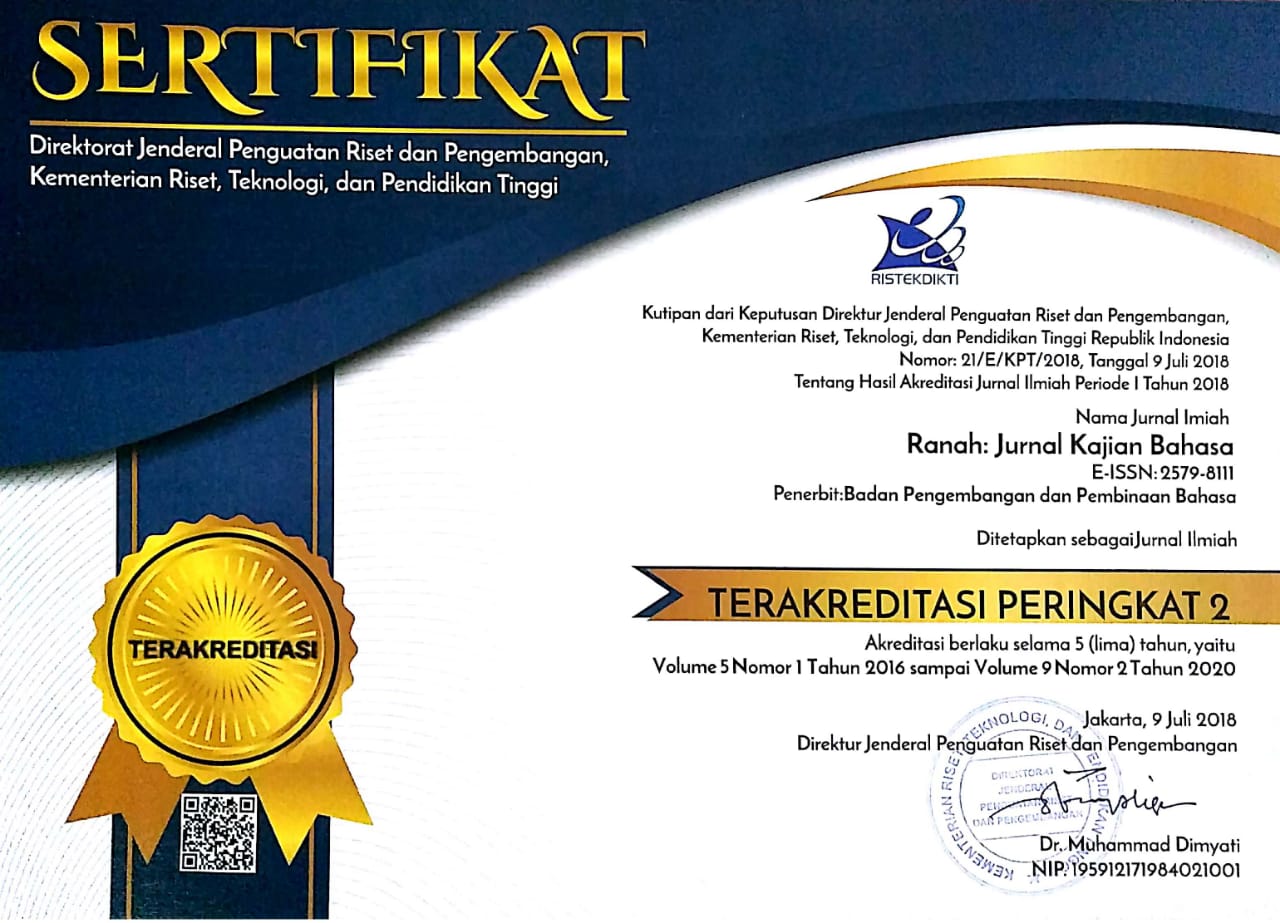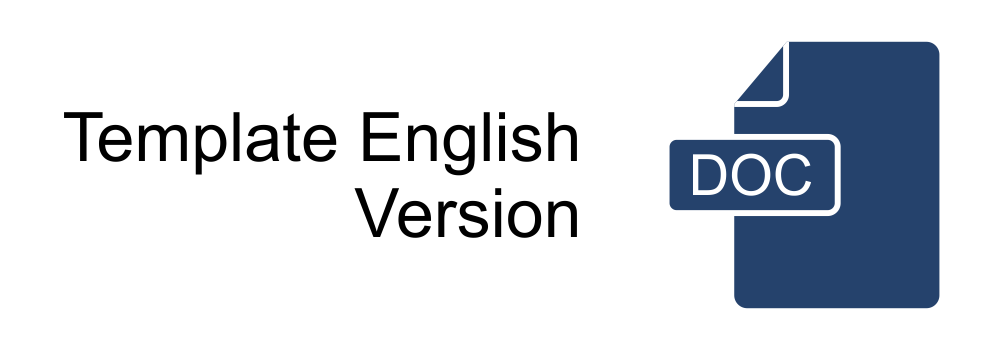Studi Ketahanan Bahasa Mandobo Atas [AAX] dan Mandobo Bawah [BWP]
Abstract
The Upper Mandobo [aax] and Lower Mandobo [bwp] languages, as minority languages, are vulnerable to extinct, especially if the government does not concern to promote the learning and use of the languages. On the other hand, Indonesian Language and South Papuan Malay are becoming stronger, because these languages are taught in schools and used in the daily life and economic transaction. Therefore, this paper would like to research the language vitality of Upper Mandobo and Lower Mandobo, that is exposed to those condition. The research method used Participatory Approach Method, with Wheel of Vitality as the survey tool, combined with EGIDS (Expanded Graded Intergenerational Disruption Scale). The data collection technique used purposive sampling and the analysis technique used qualitative approach. The research result, we found the vitality is decreasing to EGIDS 6b (endangered) for Upper Mandobo and EGIDS 7 (shifting) for Lower Mandobo. Follow up recommendations are language development for Upper Mandobo and language documentation for Lower Mandobo
Abstrak
Bahasa Mandobo Atas [aax] dan Mandobo Bawah [bwp], sebagai bahasa minoritas, memiliki kerentanan untuk punah, terlebih tanpa adanya perhatian dari pemerintah untuk mempromosikan pembelajaran dan penggunannya. Sebaliknya, Bahasa Indonesia dan Melayu Papua Selatan menjadi makin kuat, sebab bahasa tersebut diajarkan di sekolah dan digunakan sehari-hari dan dalam transaksi ekonomi. Paper ini ditujukan untuk mengkaji kembali ketahanan bahasa Mandobo Atas dan Mandobo Bawah. Metode penelitian yang digunakan adalah pendekatan partisipatoris, dengan alat survei roda ketahanan bahasa yang dipadukan dengan EGIDS (Expanded Graded Intergenerational Disruption Scale). Teknik pengumpulan data menggunakan purpossive sampling dan teknik analisis menggunakan pendekatan kualitatif. Dari analisis hasil temuan, diperoleh bahwa terdapat penurunan ketahanan bahasa menjadi EGIDS 6b untuk Mandobo Atas dan EGIDS 7 untuk Mandobo Bawah. Rekomendasi untuk menindaklanjuti pemeliharaan bahasa tersebut adalah pengembangan bahasa untuk Mandobo Atas dan dokumentasi bahasa untuk Mandobo Bawah.
Keywords
Full Text:
PDFReferences
Abas, H. (1987). Indonesian as a Unifying Language of Wider Communication: A Historical and Sociolinguistic Perspective (Issue 73). Research School of Pacific Studies, The Australian National University.
Anderbeck, K. (2010). Language use and attitudes among the Jambi Malays of Sumatra (Vol. 21). SIL International.
Anderbeck, K. (2015). Portraits of language vitality in the languages of Indonesia. Asia-Pacific Linguistics, 4, 19–47.
Anderbeck, K. (2023). Languages Map of South Papua.
Appel, R., & Muysken, P. (2005). Language contact and bilingualism (2nd ed.). Edward Arnold. https://doi.org/10.5117/9789053568576
Astuti, I. K. (2017). Vitality of Lampung language and its maintenance efforts through cultural exposure in educational program. Universitas Diponegoro.
Blommaert, J. (2010). The sociolinguistics of globalization. Cambridge University Press. https://doi.org/10.1017/CBO9780511845307
Bromham, L., Dinnage, R., Skirgård, H., Ritchie, A., Cardillo, M., Meakins, F., Greenhill, S., & Hua, X. (2022). Global predictors of language endangerment and the future of linguistic diversity. Nature Ecology & Evolution, 6(2), 163–173. https://doi.org/10.1038/s41559-021-01604-y
Chaudenson, R. (2008). On the futurology of linguistic development. In C. Vigouroux & S. Mufwene (Eds.), Globalization and language vitality: perspectives from Africa (pp. 171–190). Continuum.
Costa, J., De Korne, H., & Lane, P. (2017). Standardising minority languages: reinventing peripheral languages in the 21st century. In P. Lane, J. Costa, & H. De Korne (Eds.), Standardizing minority languages: competing ideologies of authority and authenticity in the global periphery (pp. 1–23). Routledge.
Decker, K., & Grummitt, J. (2012). Understanding language choices. SIL International.
Eberhard, D. M., Simons, G. F., & Fennig, C. D. (Eds.). (2023). Ethnologue: languages of the world (26th ed.). SIL International. http://www.ethnologue.com/
Ekklesia, D. G., & Bunga, J. P. (2023). Pergeseran Bahasa Moi [mxn], Seget [sbg], dan Kalabra [kzz] (Papua Barat). https://doi.org/10.26499/bahasa.v5i2.725
Farneubun, V. M. (2002a). Laporan Keadaan Keagamaan Suku Mandobo Atas 24 Juni 2002.
Farneubun, V. M. (2002b). Laporan Keadaan Keagamaan Suku Mandobo Bawah 5-8 Maret, 27 April-2 Mei 2002.
Farneubun, V. M. (2002c). Laporan Keadaan Keagamaan Suku Mandobo Bawah 22 April-3 Mei 2002.
Farneubun, V. M. (2002d). Laporan Survei Mandobo Distrik Mandobo dan Mindiptana Kabupaten Merauke Papua, Indonesia.
Firdaus, W. (2018). Tekanan kepunahan bahasa Suwawa: Analisis tingkat daya hidup bahasa. Jurnal Metalingua, 16(2), 307-314.
Fishman, J. (1991). Reversing language shift: Theoretical and empirical foundations of assistance to threatened languages (Issue 76). Multilingual Matters. https://doi.org/10.2307/330061
Giles, H. (1977). Language, ethnicity, and intergroup relations. Academic Press.
Grummitt, J. (2014). Wheel of Vitality: An approach to rapid vitality assessment in New Britain.
Gusmao, F. H., & Nggarang, F. (2024). Kajian Ketahanan Bahasa Kelompok Bidayuh Pegunungan Kalimantan Barat. Linguistik Indonesia, 42(1). https://doi.org/10.26499/li.v42i1.533
Gusmao, F. H., Tricahyadi, A., Nugroho, Z. C., & Saupia, R. (2023). Laporan Survei Bahasa Mandobo Atas [aax], Mandobo Bawah [bwp], dan Wanggom [wng] Kabupaten Boven Digoel, Provinsi Papua Selatan.
Heller, M. (2010). The commodification of language. Annual Review of Anthropology, 39, 101-114. https://doi.org/10.1146/annurev.anthro.012809.104951
Holmes, J. (2013). An introduction to sociolinguistics (4th ed.). Routledge. https://doi.org/10.4324/9781315833057
Jang, H.-T. (2003). Survey report on the languages of the Southeastern Foothills: Merauke Regency of Papua, Indonesia.
Karan, M. (2000). Motivations: language vitality assessments using the perceived benefit model of language shift. In M. P. Lewis & G. Kindell (Eds.), Assessing ethnolinguistic vitality: theory and practice. Selected papers from the Third International Language Assessment Conference (pp. 65–77). SIL International.
Mühlhäusler, P. (1996). Linguistic ecology: language change and linguistic imperialism in the Pacific region. Routledge.
Nahhas, R. W. (2007). Random and non-random sampling for language surveys: methods and implications.
Nettle, D. (1999). Linguistic diversity. Oxford University Press. https://doi.org/10.1093/oso/9780198238584.001.0001
Normawati, S., Sanjoko, Y., & Sianipar, J. (2007). Profil penelitian kebahasaan dan kesastraan Papua. Balai Bahasa Jayapura.
Nugroho, Z. C., & Silaen, H. C. (2024). Dinamika Ketahanan Bahasa-Bahasa Rumpun Lamaholot di Lembata. Linguistik Indonesia, 42(1), 221–245. https://doi.org/10.26499/li.v42i1.578
Quakenbush, J. S., & Simons, G. F. (2015). Looking at Austronesian Language Vitality and endangerment through EGIDS and the sustainable use model. Asia-Pacific Linguistics, 4, 1–17. http://hdl.handle.net/1885/13514
Sidabutar, A. P. (2003a). Laporan Keadaan Keagamaan Bahasa Mandobo Atas.
Sidabutar, A. P. (2003b). Laporan Survei Bahasa Mandobo Atas Kabupaten Merauke Papua, Indonesia.
Simons, G., & Lewis, M. P. (2010). Making EGIDS assessments for the Ethnologue.
Vries, L. de. (2012). Speaking of clans - language in Awyu-Ndumut communities of Indonesian West Papua. 214, 5–26. https://doi.org/10.1515/ijsl-2012-0018
Ying, H. S., Heng, C. S., & Abdullah, A. N. (2015). Language vitality of Malaysian languages and its relation to identity. GEMA Online Journal of Language Studies, 15(2), 119–136. https://doi.org/10.17576/gema-2015-1502-08
DOI: https://doi.org/10.26499/rnh.v13i1.6547
Refbacks
- There are currently no refbacks.








